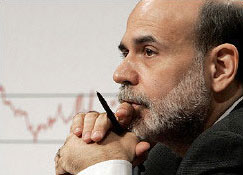 Federal Reserve Chairman Ben Bernanke said on Monday that although the shell-shocked U.S. economy has begun to see some improvement in economic activity, the recovery remains fragile and the jobless rate may remain elevated for some time.
Federal Reserve Chairman Ben Bernanke said on Monday that although the shell-shocked U.S. economy has begun to see some improvement in economic activity, the recovery remains fragile and the jobless rate may remain elevated for some time.
“We still have some ways to go before we can be assured that the recovery will be self-sustaining,” he told the Economic Club of Washington.
“Also at issue is whether the recovery will create the large number of jobs that will be needed to materially bring down the unemployment rate. Economic forecasts are subject to great uncertainty, but my best guess at this point is that we will continue to see modest economic growth next year–sufficient to bring down the unemployment rate, but at a pace slower than we would like”, he said.
On the question as to where the economy is headed, Mr. Bernanke replied:
Fed: “Recently we have seen some pickup in economic activity, reflecting, in part, the waning of some forces that had been restraining the economy during the preceding several quarters. The collapse of final demand that accelerated in the latter part of 2008 left many firms with excessive inventories of unsold goods, which in turn led them to cut production and employment aggressively. This phenomenon was especially evident in the motor vehicle industry, where automakers, a number of whom were facing severe financial pressures, temporarily suspended production at many plants. By the middle of this year, however, inventories had been sufficiently reduced to encourage firms in a wide range of industries to begin increasing output again, contributing to the recent upturn in the nation’s gross domestic product (GDP).
Although the working down of inventories has encouraged production, a sustainable recovery requires renewed growth in final sales. It is encouraging that we have begun to see some evidence of stronger demand for homes and consumer goods and services. In the housing sector, sales of new and existing homes have moved up appreciably over the course of this year, and prices have firmed a bit. Meanwhile, the inventory of unsold new homes has been shrinking. Reflecting these developments, homebuilders have somewhat increased the rate of new construction–a marked change from the steep declines that have characterized the past few years.
Consumer spending also has been rising since midyear. Part of this increase reflected a temporary surge in auto purchases that resulted from the “cash for clunkers” program, but spending in categories other than motor vehicles has increased as well. In the business sector, outlays for new equipment and software are showing tentative signs of stabilizing, and improving economic conditions abroad have buoyed the demand for U.S. exports.
Though we have begun to see some improvement in economic activity, we still have some way to go before we can be assured that the recovery will be self-sustaining. Also at issue is whether the recovery will be strong enough to create the large number of jobs that will be needed to materially bring down the unemployment rate. Economic forecasts are subject to great uncertainty, but my best guess at this point is that we will continue to see modest economic growth next year–sufficient to bring down the unemployment rate, but at a pace slower than we would like.
A number of factors support the view that the recovery will continue next year. Importantly, financial conditions continue to improve: Corporations are having relatively little difficulty raising funds in the bond and stock markets, stock prices and other asset values have recovered significantly from their lows, and a variety of indicators suggest that fears of systemic collapse have receded substantially. Monetary and fiscal policies are supportive. And I have already mentioned what appear to be improving conditions in housing, consumer expenditure, business investment, and global economic activity.
On the other hand, the economy confronts some formidable headwinds that seem likely to keep the pace of expansion moderate. Despite the general improvement in financial conditions, credit remains tight for many borrowers, particularly bank-dependent borrowers such as households and small businesses. And the job market, though no longer contracting at the pace we saw in 2008 and earlier this year, remains weak. Household spending is unlikely to grow rapidly when people remain worried about job security and have limited access to credit.
Inflation is affected by a number of crosscurrents. High rates of resource slack are contributing to a slowing in underlying wage and price trends, and longer-run inflation expectations are stable. Commodities prices have risen lately, likely reflecting the pickup in global economic activity and the depreciation of the dollar. Although we will continue to monitor inflation closely, on net it appears likely to remain subdued for some time.”
- Bulenox: Get 45% to 91% OFF ... Use Discount Code: UNO
- Risk Our Money Not Yours | Get 50% to 90% OFF ... Use Discount Code: MMBVBKSM
Disclaimer: This page contains affiliate links. If you choose to make a purchase after clicking a link, we may receive a commission at no additional cost to you. Thank you for your support!


I am not sure you can believe anything Bernanke says. He has been wrong just about everything he has been forecasting. Eventually people will realize that this guy was instrumental in destroying the dollar.
What a complete idiot. 15-20% unemploment, peolple out of work for two years+, and just more false promises by "economists" that know nothing about the real world.